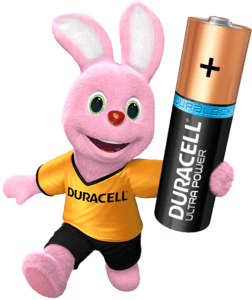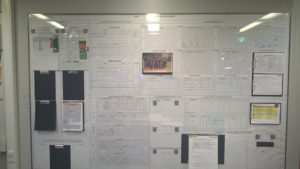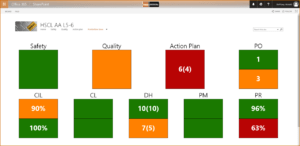
About Duracell
Duracell is the global market leader in the production of alkaline batteries, specialty and rechargeable batteries. Since the company was founded in the 1940s, it has grown to become an iconic brand when it comes to providing devices with power with compact and durable batteries. The company is known for its high quality and superior performance. The Duracell plant in Aarschot (Belgium) was founded in 1967 and nowadays it counts 450 employees. By 2020, it wants to be listed as a true “Industry 4.0 Factory”.
Therefore, in 2017, Duracell, Ometa and implementation partner Devoteam started an Industry 4.0 pilot project to raise the quality of its batteries and the efficiency of the production process to a higher level.
Duracell’s Journey to Paperless Efficiency
In 2016, Duracell did a research to find out where the biggest losses were situated on the production floor. They conducted a content analysis on all kinds of data and documents that were used within the factory. The results indicated that each year they spend more than 20,000 hours on processing documents, both digital (Excel, pdf) as on paper. Therefore, the first thing to do was to eliminate all of this paperwork and Excel sheets. In order to do so, they found Ometa as a technology partner.
During the last 20 years, over 800,000 files were gathered in more than 156 different folders. Eventually, this created chaos and employees were hardly able to find the right documents. To cope with this problem, Duracell decided to implement SharePoint as a Document Management System (DMS). This allows the company to only work with current data and to eliminate 80% of the initial 800,000 files.
Untill recently, the typical flow was that documents were being filled in, after which a key-user entered the data into his or her system. The information was then printed out again and passed on to a planner or a technician. Why? Simply because it is impossible for operators on the shop floor to work with all of the underlying systems in which data is processed. Now however, thanks to the Ometa framework, this complexity is removed. Instead, all systems and documents are linked to each other in one central SharePoint platform.
All the information about production planning, production quantities, waste percentages, maintenance, safety and quality control which used to be processed manually in different places, now flows directly and automatically towards the digital workspace in SharePoint. This is how the information is now immediately available on the work floor.
Thanks to this real time connectivity of all data into a digital workspace environment, all exports and macros of any system towards Excel have become unnecessary. Instead, these are now replaced with real time portals. Whereas in the past, technicians needed to look and search for documents, they now get them delivered at the time when they need the information. Ultimately, for Duracell, working paperless has a huge positive impact on the speed of its factory. Moreover, this new way of working will allow the company to save about 650,000 euros over the next three years.

A stable DIY integration tool
When it comes to technical choices, Pidpa always strives to make stable decisions for a long-term solution. That is why the IT department finds it very important to make informed choices. In this context, being able to start small to see if the expectations are actually fulfilled plays an important role. While experimenting with a new technology, it is also important for Pidpa to have close contact with the technology supplier. After all, it is not just about what the software can do, but also about how the relationship with the provider is. This is how Pidpa started a trial license. Also in terms of investment, it was important to be able to start small and then grow. This way, the management could be convinced systematically.
Pidpa strives to realize 80% independently with the Ometa framework. This gives them freedom of choice and it enables them to change things quickly and flexibly. For complex issues they can of course rely on the support and expertise of Ometa. Thanks to the Ometa framework, Pidpa found a stable solution that meets their needs. They found a simple way to integrate with SAP, eDOCS and AD. Ometa also offers various other integration options thanks to the built-in OData service. This offers them a uniform working method, which is a great advantage.
In addition, the tool is easy to use because it is only a matter of configuration. As a result, for some solutions the development time is reduced from weeks to days. Finally, Pidpa now has a tool that they can manage and use independently. This gives them a lot of freedom and flexibility to change or adjust their portals and solutions.

Improved internal communication
With around 700 employees, Pidpa has the constant need to optimize communication. For example, a few years ago the water company made the intranet much more dynamic and ensured that the quality and speed of information was increased. Initially, there was a huge amount of e-mail traffic within the organization, including e-mails to large groups of people. That is why Pidpa decided to make news reports and internal information such as emergency messages and announcements available via an integrated intranet. Through the new intranet, employees can make holiday requests and sickness notifications and these actions immediately pushed towards the colleagues of HR.
Thanks to the direct integration with SAP, an efficient way to follow up on all kinds of requests became possible and different actions are now managed in a uniform manner. The intranet is accessible to all employees. For the workers who are always on the road, the intranet is made available on tablets. This last example is closely related to the fact that Pidpa has a diverse staff park. This means that there are employees who are very familiar with SAP, but at the same time there are also many employees who have no experience with the system. For the latter group, the integrated intranet means that they can receive information from and can write back to SAP in realtime via user-friendly SharePoint portals.
A very striking example is the registration of deviations in SAP. Deviations can be seen as defects or malfunctions (e.g. to a sewer system). Previously, it often occurred that employees had no access and / or knowledge of SAP. Consequently, a manual data transfer was necessary with the additional disadvantage that the data was not always up to date. This has been solved because employees can now register and update deviations in SAP via simple web forms.
Success lies in the people
Two factors are very important in this transition. First of all, it is important to divide the project into manageable parts that you solve one by one. That is one of the biggest challenges. Secondly, you need the support of the entire company. You need the support of the management, you need strong leadership and need the cooperation of people on the work floor to get things going. This requires vision and organization.
For this project, Duracell has put together a ‘core team’ with staff who voluntarily participate. Especially the operators are involved in this project. It is not technically inspired and the people on the floor decide together with their team leaders what they find important. Engineering and IT follow that core team to achieve what is put forward. We always work with a lead model: we make a proof of concept and we work that out with input from several people.
After that, one or two teams test it out in reality and they then provide feedback. Based on this, the solution is rebuilt or optimized and only at that point the system is rolled out. We therefore proceed step by step and the input of the employees is very crucial. We also communicate a lot with the staff about this. The whole project is very interactive and the final application will not come as a surprise to our staff.


